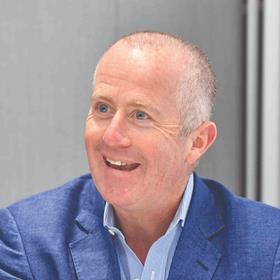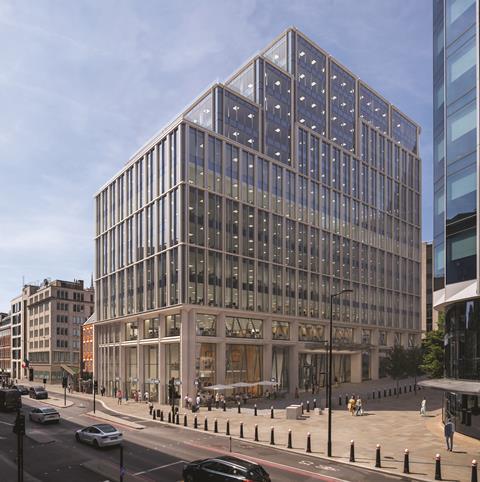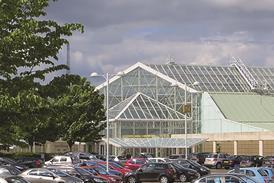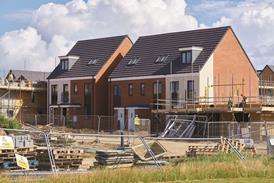How do we respond to evolving requirements for office buildings? That is the big question on the lips of architects, developers, asset managers and tenants, who face a fast-changing world that has seen not only work patterns, behaviours and office needs turned on their head by the Covid-19 pandemic but climate concerns brought to the fore, too.

Expert panel
- Julian Sharpe, principal director, tp bennett
- James Elliott, director, tp bennett
- Shane Kelly, principal director, tp bennett
- Peter Bovill, partner, Montagu Evans
- Nick Clare, head of commercial, Turner & Townsend
- Aoife McEvoy, development director, Argent
- Tina Paillet, RICS president and ceo / co-founder Circotrade
- Rupert Perkins, director, Squarebrook
- Edmund Reed, managing partner, Travers Smith
- Richard Saul, senior director, asset management and development, Ivanhoé Cambridge
- Ed Thomson, associate director, CO-RE
- Mel Flaherty, deputy editor, Property Week
- Lewis Berrill, reporter, Property Week











Property Week, in partnership with architect tp bennett, gathered a panel of experts and stakeholders to discuss the best practices for delivering high-quality, future-proof offices.
The discussion started with a presentation on One Stonecutter – a 13-storey office block at One Stonecutter Street in Farringdon, London, designed by tp bennett and set to be completed by the first quarter of 2025.
The development, managed by CO-RE working alongside Ivanhoé Cambridge and new 50:50 joint venture partner Allianz Real Estate, will provide 250,000 sq ft of office space with amenity-rich features including retail units, roof gardens and a recreation of the existing courtyard space, relocating and repurposing it as an open green space for tenant and public access alike.
International law firm Travers Smith has signed a 158,000 sq ft pre-let to make the building its new London headquarters – signalling confidence in the building’s ability to not only meet today’s needs, but to continue to do so many years into the future. The building has a further four floors available.
Compelling stories
This led neatly into the first discussion point of the event: the importance for planners, investors and tenants of a building’s ability to tell a compelling story about itself and its neighbourhood. “When we act for clients, more and more people are looking for these things,” said Julian Sharpe, principal director at tp bennett. “They are starting their search looking for outside amenities and urban permeability; they are interested in the story and authenticity of a building.”
Peter Bovill, partner at Montagu Evans, agreed. He said he believed the “authenticity” of a building was one of the biggest drivers behind whether it was a desirable property.
“People want a story,” he said. “It can’t just be some anodyne office building. Both the people who are building it but certainly the people who are going to be occupying it, they want their staff to have an element of ownership of the building rather than it just being some blank canvas, and it needs a great story to create that sense of ownership.”
Bovill adds: “The City of London planners love that. They love being able to connect between the old and the new.”
Edmund Reed, managing partner at Travers Smith, admits the narrative woven into the design of One Stonecutter was a large draw for the firm when it signed its lease.
“We have been in our existing site in Snow Hill since the 1980s and it has a very clear identity near Smithfield, and that has always been something that has been a part of Travers Smith’s DNA,” he said.
“We wanted a new building with a similarly clear identity to refresh that DNA. I think if we had found a building that looked great but frankly was a faceless blank canvas, that would not have been as appealing. The fact that this has an identity and that is rooted in the location is really important for us.”
Rupert Perkins, director of Squarebrook, said Travers Smith’s attitude towards story and identity is reflected across the industry: “The brand that is delivered by a building, and very much the relevance of a building in that location, is so important because it does reflect both on the external image of the business and the staff who work there.”
Location, location, location
A building can tell a compelling story, but ultimately to be an attractive place for staff to work, and thus to allow a business to be competitive in the job market, it must be in the right location.
“Time and time again it comes down to location. That can be a huge emotional draw for people,” said Ed Thomson, associate director at CO-RE. “Are they in a place they can recognise and be proud of?”
However, the definition of a good location is changing. In a world where staff are used to working from home and are no longer happy to lose hours of their day commuting, staff want offices they can easily travel to and from, whether by public transport or bicycle.
“We are seeing more people focused on transport and getting to the office,” said Nick Clare, head of commercial at Turner & Townsend. “It’s certainly more important now than ever, with trying to get people back into the working environment, back into the office. The location [in relation] to transport hubs is a huge driver – nobody wants to travel for two and a half hours to and from work.”
Aoife McEvoy, development director at Argent, agrees proximity to transport hubs is important, but adds that a business cannot simply up sticks and move across the city to be next to a better-connected rail station.
People want something to encourage them back in a post-pandemic world
Richard Saul, Ivanhoé Cambridge
“For most businesses, their staff are an established workforce who have chosen their homes and locations in relation to transport hubs,” she said. “If you are moving to a very different location within the city, that can be a lot of upheaval for people in terms of their family arrangements, their transport arrangements or other things such as gyms or communities they engage with, wider to the office.”
Reflecting on how the pandemic has changed perspectives on work and offices, Richard Saul, senior director, asset management and development, at Ivanhoé Cambridge, said: “One of the other major aspects of encouraging people back to the office, and making them feel like they want to come to the office, notwithstanding the transport, is the amenity and the experience that they get.
“People want something to encourage them back in a post-pandemic world. You cannot offer them an uninspiring office and expect them to be there five days a week. It needs to be somewhere that delivers an experience.”
Repurposing versus rebuilding
A very topical subject of debate, in light of Westminster’s proposed amendments to its City Plan and the recent High Court ruling against secretary of state Michael Gove’s decision to oppose M&S’s demolish-and-rebuild plan for its flagship Marble Arch store, is whether it is better to retrofit an existing building or start from scratch. This discussion can often focus on embodied carbon. However, the roundtable attendees agreed that the deciding element was often operational and commercial viability.
James Elliott, director at tp bennett, said: “With One Stonecutter, we spent the first nine months trying to make the existing building work on a practical level. However, transforming the existing building into a responsive and desirable environment was just not feasible. We did ensure as many of the foundations as possible could be reused to save the embodied carbon.”

CO-RE’s Thomson added: “The world of retrofit is changing rapidly. The level at which you can recycle and repurpose buildings easily and quickly is evolving at pace. Raised access floors is the obvious one – everyone knows if there is a raised access floor we can reuse it, but now we are going slightly further down that path where more and more is possible.”
RICS president and chief executive Tina Paillet said she believed the future would see more and more repurposing of materials, as technology and methods in the sector evolve. “You can now build a new build but using reused materials,” she said. “And reused steel is becoming more popular and there are all sorts of tools now to identify whether the reused steel can be used within your structure and your scheme. That sector is really moving fast. I think, for low carbon, it’s going to be more and more reused materials.”
Squarebrook’s Perkins added: “The whole point about repurposing is that today’s buildings should be built to be able to be repurposed more comfortably in the future, as well as all the sustainability issues that we are familiar with.
“The right product is not only fit for the purpose of business, but also meeting the ESG [environmental, social and governance] requirements. How long is a new building designed to last for? Is this building good for the next 30 years or will it be 100?”
Focus on sustainability
The panel also discussed how sustainability had moved up priority lists for modern offices. Architects want to deliver modern buildings that protect the environment, creditors will provide better interest on financing of green buildings as they are easier to sell and tenants want buildings to help them reach net zero goals.
Referencing sentiment surveys carried out by RICS, Paillet said: “It’s not the changing work patterns that are driving top-tier demand; it’s the energy efficiency. That’s really the driver for changing office space.

“I would have thought initially that it was being driven at least as much by downsizing because of remote working but it turns out that actually it’s because of legislation coming of needing to have EPCs [Energy Performance Certificates] at the right level and because of corporate engagement in reaching net zero. These commitments mean that when you take a building it’s more about its carbon profile and how fit for purpose it is for climate change.”
According to Shane Kelly, principal director at tp bennett, the green credentials of new buildings have moved to the top of tenants’ wish lists.
“Efficiency, sustainability and flexibility, along with floorplate, are now the most important considerations for a building,” he explained. “A big achievement at One Stonecutter was delivering a 20,000 sq ft floor that is largely column-free. As a workspace it is not only compelling from a space planning point of view but, with its great natural lighting, from an efficiency point of view, too.”
McEvoy added: “It’s a wide matrix of balancing what you are trying to do to achieve your net zero carbon targets.”
As is often the case with ESG targets, the big question is how carbon is monitored and how environmental efficiency is categorised.
“What is going to be important is your carbon profile and whether or not your building is going to make it to the Paris Agreement targets,” Paillet said.
“The certifications will start morphing into something that measure more operational carbon than today’s certifications. If you are trying to capture the entire carbon footprint, from a whole-life-carbon assessment standpoint, that’s what is going to count. And I think we are going to see a whole new profession – carbon accountancy and accredited carbon assessors.”
Perkins added: “Certifications definitely still have a place but it may be that we have the wrong set of certifications. However, they definitely drive developers to make sure that they reach their environmental targets and they allow occupiers to compare buildings against each other in a relatively straightforward manner.”
































No comments yet